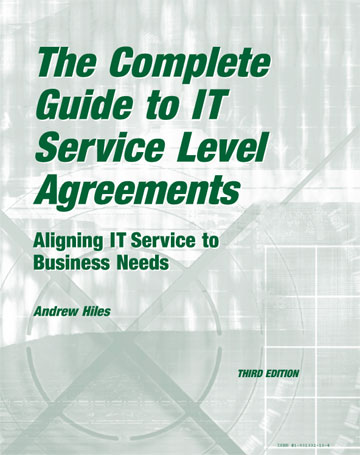Description
Most suppliers lose around 16% of their customers each year. The reason? Poor service – whether perceived or real. Any technology-based support service, whether in-house, contracted or outsourced, stands to be accused of being insensitive to the requirements of its customers (or users). Equally, customers of a support service may have unrealistic expectations of what can be reasonably provided. Service Level Agreements (SLAs) can overcome these gulfs. A Service Level Agreement can create harmony between parties and can prevent disputes between customers and suppliers. It can justify investment and identify the “right” quality of service. It can mean the difference between business success and failure. SLAs are potentially a strategic tool to align all support services (particularly IT) directly to business mission achievement. In the past, few organizations used them in this way.
Armed with this book, more and more businesses are now succeeding.
Where are Service Level Agreements going? Increasingly business-focused. Increasingly measured in real-time. Simple documents that cover complex service infrastructures. Providing a competitive edge. Embracing penalties. The brave, who commit to tight SLAs and perform against them will win the commercial spoils. This book provides the knowledge and tools based on fifteen years of intensive development to ensure your enterprise is among the winners.
A Rothstein Publishing Classic Title. 2002, 278 pages.
Contents
ACKNOWLEDGEMENTS…………………………………………………………………………………… iv
FOREWORD……………………………………………………………………………………………………….. xi
PREFACE TO THE THIRD EDITION………………………………………………………………. xiii
1 AN OVERVIEW OF SERVICE LEVEL AGREEMENTS: WHAT THEY CAN
AND CANNOT DO……………………………………………………………………………………………… 1
1.1 Introduction 1
1.2 Service Level Agreements: Definition 5
1.3 Serving the Business 9
1.4 Availability 11
1.5 Performance: Speed, Response and Accuracy 14
1.6 Security 15
1.7 Quality 15
1.8 Service Culture 16
1.9 But Why SLAs? 17
CHECKLIST #1.1: Service Orientation 19
2 THE MEASUREMENT OF SERVICE AVAILABILITY AND QUALITY:
KEY METRICS AND TECHNIQUES………………………………………………………………… 25
2.1 Availability: Optimizing Uptime 25
2.2 Change Management 27
2.3 Problem Management 29
2.4 Critical Component Failure Analysis 29
Table 2.1: Critical Component Analysis – Cumulative Availability………………………… 32
Table 2.2: Contacts for Monte Carlo Analysis Tools……………………………………………. 33
2.5 Relationship with Security and Contingency Planning 34
2.6 Scope of Service 36
2.7 Service Products 37
2.8 Service Hours 39
2.9 Real Time Interactive Services 40
2.10 Batch Services 41
2.11 Output Arrangements 41
2.12 Telecommunication and Network Services 42
2.13 Outsourcing 45
2.14 Applications Development Services 50
2.15 Distributed Processing 50
2.16 Help Desk and Technical Support 51
2.17 Internet and Intranet Based Services 51
2.18 Security Services 53
2.19 Special Requirements 53
2.20 Personal Computing 54
- 21 Customer Self Computing 55
2.22 Training 55
3 HOW SERVICE LEVEL AGREEMENTS APPLY IN AN APPLICATIONS DEVELOPMENT ENVIRONMENT………………………………………………………………………………………………….. 57
3.1 Applications Development 57
3.2 Development Environment 61
3.3 Feasibility Study 61
3.4 System Analysis/Specification 62
3.5 System Design 62
3.6 Invitation to Tender/Contract 63
3.7 Implementation 64
3.8 Post-Implementation Review 64
3.9 Service Orientation 65
4 KEYS TO MEASURING AND MONITORING SERVICE; DESIGNING AND IMPLEMENTING AN SLA…………………………………………………………………………………………………………………….. 67
4.1 Introduction to Service Measurement…………………………………………………………………. 67
4.2 Measuring Performance and Availability 68
4.3 Monitoring Tools and Their Use 70
4.4 Application Monitoring 71
4.5 Network Monitoring 72
4.6 Case Study 74
4.7 Systems Monitoring 74
4.8 Satisfaction Monitoring 75
4.9 The Service Management Toolkit 76
4.10 Monitoring & Litigation 78
4.11 Balancing Detail with Practicality 78
- 12 The Balanced Scorecard 79
4.13 What to include in a SLA 80
4.14 Shell, Template, Model and Standard SLAs 83
- 15 The Service Handbook 87
- 16 Service Level Survey 88
4.17 Charging for Services 90
- 18 Infinite Capacity and 100% Availability? 96
4.19 Realistic Limits to Service 98
4.20 Penalty Clauses 100
4.21 Planning For Change 103
4.22 Organizational Issues 103
4.23 Preparing the Ground 107
4.24 Pilot Implementation 108
4.25 Negotiating with the Customer 110
4.26 Reporting Actual Performance Against SLA 111
4.27 Service Review Meetings 121
4.28 The Customer Review Meeting 121
- 29 Service Motivation 122
4.30 Extending SLAs 123
Annex One: Example Customer Satisfaction Survey 125
Annex Two: Example Service Level Survey 130
Annex Three: Terms of Reference for Marketing & Sales Manager and Accounts Manager 134
Annex Four: Monitoring Tools – Web Addresses 137
5 THE DOWNSIDE RISK; ALTERNATIVES TO SERVICE LEVEL AGREEMENTS; THE SLA PAYOFF…………………………………………………………………………………………………………….. 139
5.1 SLAs: Reasons for Failure 139
5.2 Alternatives to SLAs 141
5.3 Performance Indicators 142
5.4 Availability and Response Targets 143
5.5 Benchmark Checks 146
5.6 Business Satisfaction Analysis 147
5.7 The SLA Payoff: A Success Story 153
5.8 Where Next? 154
5.9 Conclusion 155
APPENDICES 157
APPENDIX A: SERVICE LEVEL AGREEMENT CHECKLIST 159
APPENDIX B: Example Desktop Support Metrics 185
APPENDIX C: TRADITIONAL, IT-ORIENTED SLA …………………………….191
APPENDIX D: Example Simple Development SLA 207
APPENDIX E: Checklist for Outsourcing & Facilities Management 221
APPENDIX F: EXAMPLE DESKTOP SUPPORT SLA 225
BIBLIOGRAPHY……………………………………………………………………………………………….. 273
ABOUT THE AUTHOR………………………………………………………………………………………. 275
Figure 1.2: Serving the Business…………………………………………………………….. 11
Figure 2.2:Definitions for Telecommunication Service Levels……………………… 44
Figure 3.1: Development using FPA………………………………………………………… 60
Figure 3.2: Development Environment…………………………………………………. 65
Figure 4.1: Service Management Toolkit…………………………………………….. 77
Figure 4.2: Example of Balanced Scorecard…………………………………….. 80
Figure 4.3: The One Page SLA Format…………………………………………………….. 85
Figure 4.4: The One Page SLA Format…………………………………………………….. 86
Figure 4.5: Components of Service Level Management…………………. 89
Figure 4.6. Charging for Computing Services – Schematic………….. 94
Figure 4.7. Back-to-Back SLAs…………………………………………………………………. 100
Figure 4.8: Cost of Real-time Service Outages………………………………. 101
Figure 4.9: Hierarchy for SLA Implementation………………………………… 104
Figure 4.10: Customer Account Manager: Liaison Points……………. 106
Figure 4.11a: Monthly Report……………………………………………………………….. 112
Figure 4.11 b: The Same Data, Weekly Report…………………………………… 113
Figure 4.11c: The Same Data, Daily Report………………………………………… 113
Figure 4.12. SLA Reporting Schematic…………………………………………………. 115
Figure 4.13: Global Service Report – Schematic……………………………. 117
Figure 4.14a: Sample SLA Report…………………………………………………………… 118
Figure 4.14b: Batch Service Level Report…………………………………………. 119
Figure 4.15. Computing Center – Mainframe Availability, 0800 to 2000 hours..120
Figure 4.13. Components of Service Level Management…………….. 124
Figure 5.1. Explicit Service Targets……………………………………………………. 144
Figure 5.2a: A CAD Benchmark…………………………………………………………………. 148
Figure 5.2b: CAD Response – Benchmark Drawing Time…………………. 149
Figure 5.2c CAD Response – Benchmark Drawing Time…………………. 150
Figure 5.2d: CAD Response – Benchmark Drawing Time…………………. 151
Foreword
Most suppliers lose around 16% of their customers each year. The reason? Poor service. Typically if you provide good service, your customer may tell five people. “Customer promiscuity” is the norm: your customers and prospects are one click away from your competitors. Discontented customers typically tell over ten people how bad you are. In the days of bulletin boards, a discontented customer can place messages that can impact – maybe even destroy – your business. In the often dangerous and unpredictable e-world, Service Level Agreements are imperative to protect both parties.
Any support service, whether in-house, contracted or outsourced, stands to be accused of being insensitive to the requirements of its customers (or users). Equally, customers of a support service may have unrealistic expectations of what can be reasonably provided by it. Service Level Agreements can overcome these gulfs.
All too often service level reports are misleading: bad statistics, measured in ways and at points that do not truly reflect the service experience of the customer. This book exposes pitfalls, problems and challenges in e-business Service Level Agreements and lays the foundation for harmonious and effective customer-supplier relationships to enable actual service delivery to become aligned to customer expectations.
What, then, is a Service Level Agreement? A Service Level Agreement is simply an agreement between the support service and the user quantifying the minimum acceptable service to the user. SLAs are particularly valuable in real time activities of e-commerce where speed-to-market is crucial; where there is no time for mistakes; and where millions of dollars can be lost in minutes.
A Service Level Agreement can create harmony between the parties, and avoid disputes between customer and supplier. It can justify investment and identify the “right” quality of service. It can mean the difference between business success and failure.
Dr Yvonne Gunn
Kingswell International
Preface
Some 15 years ago, the UK IBM Guide Operations Managers group (of which I was Chair) held a meeting in which we discussed the concept of SLAs. I had read about the pioneering work in this area by Bill Miller of American Airlines and developed by the Capacity Management Group. Seizing on the concept as good management practice, I first implemented them in the company for which I was then working. It really was leading edge stuff in those days and there was little guidance, so in 1988 I began to present training workshops on the topic. These aroused considerable interest and I was persuaded to write the first book on the subject, published by Elsevier. Believing this concept was equally applicable to any support or supply service, the second book, suggesting this transition, quickly followed. We began to receive inquiries about SLAs from a wide range of public and private sector enterprises, covering a broad spread of business and support functions. Since then we have presented on SLAs at conferences and workshops around the world and written literally hundreds of articles on the subject.
My vision in SLAs is simple: SLAs are potentially a strategic tool to align all support services (especially IT) directly to business mission achievement. Sadly, few organizations use them in this way.
The early SLAs were IT-centric, written in IT technical terms, and predominantly provided the IT user with service levels that had more to do with internal IT performance measurements than with business-oriented service achievement. Frequently metrics were inappropriate, measurements imprecise and monitoring weak. The SLA reports simply did not reflect the experience of the customer when using the service. Now, the more mature organization writes business-centric SLAs and has sophisticated performance measurement tools that accurately reflect the customer’s or service user’s actual experience. Unfortunately, we are now seeing the legal profession moving into the field of drafting SLAs, changing the concept from a crystal-clear definition of the service and of service levels, back into a muddy, legalistic puddle.
Back full circle? It’s time to start over.
That is why this book is particularly important today. We must keep the service vision, definition and requirements clear – even more important today in a time of loose partnerships, complex – often virtual – supply chains and instant success or failure. In the e-world, particularly, customers are just one click from desertion.
Where are SLAs going? Increasingly business-focused. Increasingly measured in real-time. Simple documents that cover complex service infrastructures. Providing competitive edge. Embracing penalties. The brave, who commit to tight SLAs and perform against them will win the commercial spoils.
Andrew Hiles
Oxon Bagpuize, England




